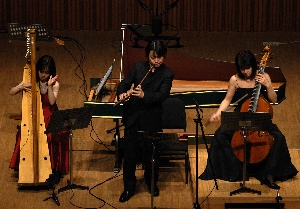Yoshimichi Hamada |
Recorder & Cornett
|
|---|
Kaori Ishikawa |
Viola da Gamba
|
|---|
Marie Nishiyama |
Cembalo&Harp
![marie031[1].jpg](_src/sc717/marie0315B15D.jpg) Marie Nishiyama graduated from the piano department of Tokyo Music University, and also received her master's degree in cembalo there. She studied under Yoshio Watanabe (cembalo) and Yoshiko Ueda (organ). She entered the Schola Cantorum Basiliensis to study with Rinaldo Alessandrini and Nicolau de Figueiredo (cembalo), Heidrun Rosenzweik and Mara Galassi (historical harp), Jesper Christensen (Basso continuo, ensemble), and Pedro Memelsdorff (medieval ensemble). Among other awards and accolades, she won first prize in the 11th Yamanashi Early Music Festival for her cembalo performance. She is a member of "Anthonello", and an accomplished international soloist in both cembalo and historical harp. She also has been involved in many recordings not only in Japan but also in European countries including Italy and Spain. Her highly acclaimed original recording "Taner Fantasia - Spanish keyboard music" (released 1999 in Japan) made its Spain release in 2003, and was chosen as the most recommended CD by a Spanish journal. Each of her solo albums, "Dance du Roy et Chonson " (renaissance harp), "Lamento di Tristano" (medieval gothic harp), "Jupiter - Les orages des passions - Forqueray Pieces de Clavecin" and "J. S. Bach French Suites" (cembalo) has continued to receive high praise and recommendation from many Japanese journals and newspapers. Since 2007, she has released a series of J. S. Bach's main keyboard works under the "Anthonello Mode" label. Marie Nishiyama graduated from the piano department of Tokyo Music University, and also received her master's degree in cembalo there. She studied under Yoshio Watanabe (cembalo) and Yoshiko Ueda (organ). She entered the Schola Cantorum Basiliensis to study with Rinaldo Alessandrini and Nicolau de Figueiredo (cembalo), Heidrun Rosenzweik and Mara Galassi (historical harp), Jesper Christensen (Basso continuo, ensemble), and Pedro Memelsdorff (medieval ensemble). Among other awards and accolades, she won first prize in the 11th Yamanashi Early Music Festival for her cembalo performance. She is a member of "Anthonello", and an accomplished international soloist in both cembalo and historical harp. She also has been involved in many recordings not only in Japan but also in European countries including Italy and Spain. Her highly acclaimed original recording "Taner Fantasia - Spanish keyboard music" (released 1999 in Japan) made its Spain release in 2003, and was chosen as the most recommended CD by a Spanish journal. Each of her solo albums, "Dance du Roy et Chonson " (renaissance harp), "Lamento di Tristano" (medieval gothic harp), "Jupiter - Les orages des passions - Forqueray Pieces de Clavecin" and "J. S. Bach French Suites" (cembalo) has continued to receive high praise and recommendation from many Japanese journals and newspapers. Since 2007, she has released a series of J. S. Bach's main keyboard works under the "Anthonello Mode" label.
Her official site:http://marienishiyama.com/
|
|---|



 LINKS
LINKS